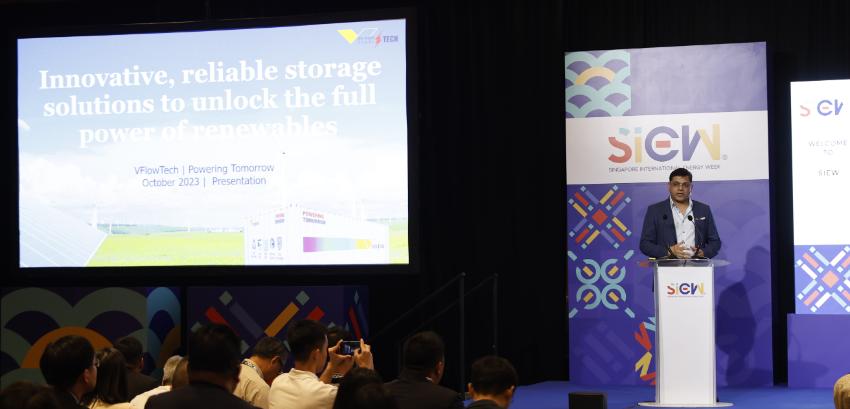Renewable energy innovations and reduction in flow battery costs converge to provide a cost-competitive solution to power the net zero transition. Kwok Sher Wei reports.

As the world races towards a sustainable energy future, the demand for sustainable solutions becomes more pressing than ever. As Dr Avishek Kumar, Co-Founder and Chief Executive Officer, VFlowTech, noted at SIEW TechTable on 25 October, the net zero transformation is "a very complex problem, and it needs multiple technologies to come together".
Speaking on the topic of Energy Storage System: How Flow Battery Technology can Pave the Way for Net Zero Transition, he shared that these unassuming yet powerful electrochemical storage systems are at the forefront of sustainable energy solutions. While the cost of renewable energy has plunged to less than 2 cents per unit, this comes with significant limitations—intermittency. Solar power wanes at night, while wind availability depends on seasons and locations.
The solution? For Dr Kumar, the answer lies with Long Duration Energy Storage, particularly in the form of flow batteries.
Three compelling reasons why flow batteries can lead the charge
Flow batteries have mostly remained in the shadows, primarily due to their initial high cost and low efficiency, which posed significant challenges. However, the tide has turned for this technology, thanks to extensive research and innovation. Today, flow batteries stand as a viable and cost-competitive energy solution against traditional fossil fuels such as coal.
Unlike conventional batteries, flow batteries are a type of electrochemical energy storage technology that stores energy in liquid form. They offer an impressive 25-year lifespan and are considered to be safer to use since the electrolytes employed are virtually non-flammable. This makes flow batteries a strong candidate for integration with renewables, providing a stable and reliable power supply.
Dr Kumar highlighted three key reasons why flow batteries are now set to lead the way:
- Cost reduction: Extensive research and development efforts have greatly reduced the cost of flow batteries. Notably, recycling of vanadium, the primary chemical used in these batteries, has played a pivotal role in cost reduction.
- Low carbon footprint: Companies like VFlowTech have taken steps to reduce the carbon footprint of flow batteries by recycling industrial waste from Jurong Island to produce vanadium. This approach has resulted in a carbon footprint that is 300 percent lower than that of conventional batteries.
- Scalability: Flow batteries are easily scalable, given that their electrolyte tanks can be accurately upsized and stacked vertically to match varying energy demands.
Applications beyond borders
Dr Kumar shared that VFlowTech's ambition is "to power the world with batteries and support the Singapore energy transition with a few giga batteries in the region".
Beyond the test-bed projects in Singapore, he shared where flow batteries are making a tangible difference, improving energy access in remote and land-constrained areas:
- Hospitals in Africa: Flow batteries are replacing chunky diesel engines to power hospitals in remote areas of Africa. This is helping to provide access to cleaner electricity that is also cost-competitive with existing options.
- Space-constrained urban areas in South Korea: Flow batteries are being employed to store excess renewable energy in underground tanks. This surplus energy is then used to support electric vehicle charging and energy trading, highlighting the multiple applications and versatility of flow batteries.
Overcoming barriers to wider deployment
While flow batteries show great promise, Dr Kumar highlighted three areas where more can be done to advance widespread adoption:
- Policy: Policymakers play a crucial role in advancing the adoption of flow batteries. Clear and supportive policies provide incentives for both users and manufacturers in driving the energy transition. Dr Kumar cited the example of the US' Inflation Reduction Act (IRA): "IRA is a phenomenal policy that promotes energy storage. If you're a user, you get an incentive to deploy. And if you’re a manufacturer, you get an incentive."
- Financing: Subsidising the cost of manufacturing and incentivising research and development (R&D) are essential. In the absence of R&D efforts, the product's potential for improvement remains unrealised. This leads to a challenging conundrum akin to a "chicken and egg" situation. Overcoming this requires a leap of faith, often supported by sovereign funds.
- Digitalisation: Integrating Artificial Intelligence-enabled Energy Management Systems and software productivity holds great potential for flow batteries. It can go a long way to optimising battery sizing and providing users with the flexibility to control and maximise the energy stored and released.
Powering the energy transition
Dr Kumar highlighted the significance of flow batteries in the energy transition towards a net zero world. Their safety, longevity, scalability, and cost-effectiveness, not to mention their lower carbon footprint, make them a compelling choice to drive forward the energy transition.
As we navigate the path to net zero, the emergence of flow batteries as a viable solution raises important questions. These include what other new technological innovations could be at the forefront of net zero discussions. The energy transition is, undoubtedly, a technological game, and potentially game-changing innovations like flow batteries could very well define the future of clean and renewable energy.